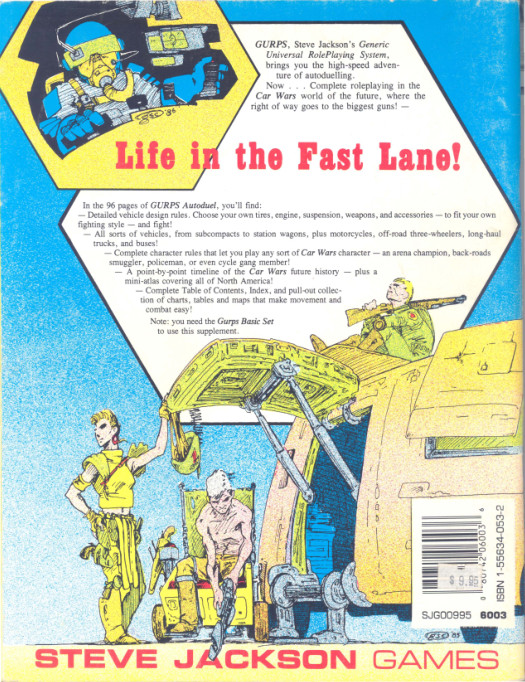GURPS Autoduel by Alien Rope Burn
Introduction
Original SA postHumbug Scoolbus posted:
GURPS Car Wars?

Car Wars was my first game that went past Monopoly in complexity. I remember seeing the Deluxe Edition while a parent was at a hobby shop for... some reason. Models, I think? It had nothing to do with Car Wars . I'm not sure why it rang a cord with me, but it was probably Denis Loubet's striking cover. So when I saw a copy of Mini Car Wars for $1 months later, I was primed, and by Christmas, I had a copy of Car Wars Deluxe Edition sitting under the tree. I loved it even with all the math I had to master to play it.
But covering Car Wars Deluxe Edition isn't vastly interesting, it's a big chunk of rules telling you how to craft just about any motorized wheeled vehicle plus helicopters, attach guns and armor, and then make it fight. There's a setting, but it literally only gets a page or two of discussion. Plus, System Mastery covered it . I mean, sure, I know the game backwards and forwards, but I don't think I could make it interesting to describe.

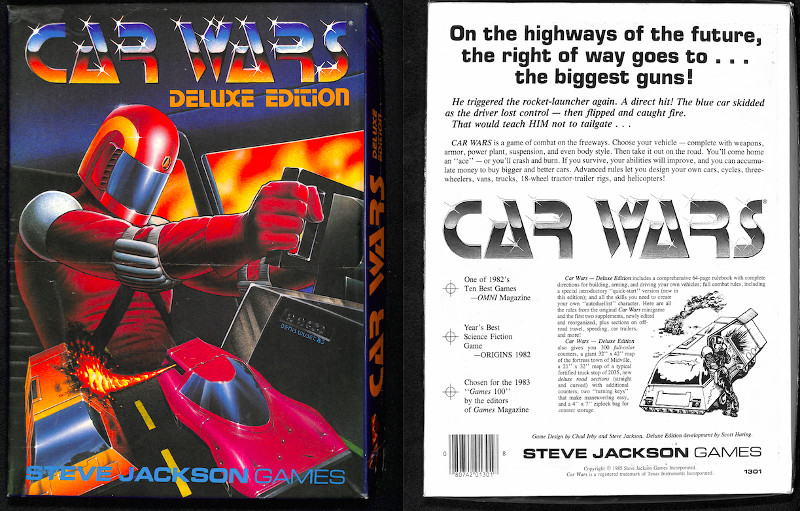
I considered the first supplement for Car Wars , Autoduel Champions , but it has the same problem where it's mostly just a contiguous set of rules: a set of vehicle rules for Champions followed by a set of superhero rules for Car Wars . Once again, it only gets a few pages of setting in which we are told by Aaron Allston that it's mostly just a western with cars, given a metaphorical slap on the ass, then shoved off to run a game, because that's what you did in these days. You pushed GMs into the deep end of the pool and told them learn to swim, babies . Well, it was the '80s.
And, in fact, it's still the '80s as we get to GURPS Autoduel and the actual subject of the review. Now, this isn't to be confused with GURPS Autoduel 2nd edition , which removes the vehicle design rules and instead requires GURPS Vehicles . No, by modern standards, the original GURPS Autoduel is a textbook of example of how to use space efficiently, giving us not only a rather detailed setting, campaign advice, two adventures, but complete car design rules for GURPS in 84 pages. Now, this was written in 1986, so it was intended for use with the 1st or 2nd edition of GURPS , but works with the 3rd edition perfectly well, though there might be some conflicts with the gun rules - since 1st and 2nd editions of GURPS , amazingly, didn't have fully-fledged firearms rules. 4th edition gets trickier, but you could probably use this a modicum of adjustment. It's just not a system that's undergone truly radical changes, but rather incremental changes.
Part 1: Introduction
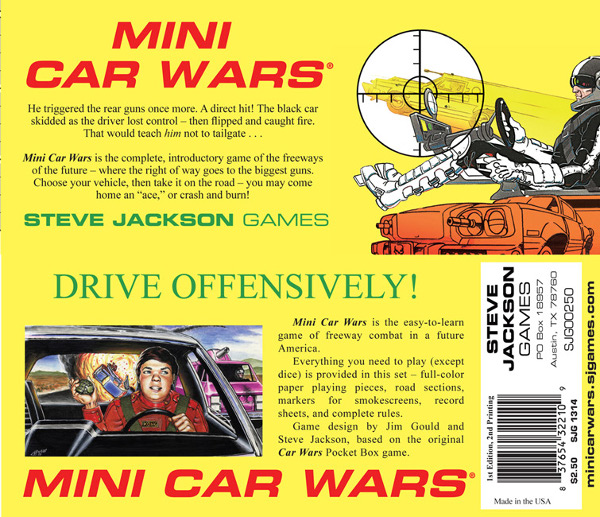
So, Car Wars was at first a board-game in which people played drivers in a post-post-apocalypse where America (and most of the world) experienced a societal collapse. During this time of lawlessness, violent arena sports gained popularity, most notably autoduelling, born out of demolition derbies where competitors got the idea to start putting guns on their cars. And though the America of Car Wars is in a recovery period and rebuilding civilization, "autoduelling" and other blood sports are still popular. Of course, given the lawlessness of rural areas and roads, particularly the rise of heavily-armed cycle gangs, having a gun on your car becomes the standard for society. In fact, it becomes the only thing that brings America back from the brink. Society is saved by the proliferation of arms, particularly armed cars.

Of course, the real reason was "Steve Jackson got frustrated in traffic and thought he'd really like to shoot other drivers", so he got together with his gamer Chad Irby and made a game about that. Chad Irby did at least one article I found in Space Gamer , then fell into a black hole as far as the gaming world is concerned, though but I have reasonable evidence that he's still alive. Steve Jackson, on the other hand, went on to make a few supplements for the game before a disastrous revision in 2002. Without going full grog, all you need to know is that they tried to sell two-packs of vehicle designs in a game that previously published "vehicle guides" with upwards of two-hundred packs of vehicle designs. It was seen rightly as gouging, and coming out in era where d20 was taking everybody's lunch money as it was, it never had a chance. Car Wars vanished as a going concern until the recent reprints of some material from the original game, going on the nostalgia pull of Steve Jackson's highly successful OGRE kickstarter. Though a new edition of Car Wars was promised as part of the a kickstarter, only reprints have emerged so far.
But enough about Car Wars ! We're here for GURPS , a name that will never, ever, not sound silly. GURPS Autoduel was the product of two writers. The first is Aaron Allston , mainly known to the public as a sci-fi and Star Wars novel writer, but would be better known to gamers as the primary author behind D&D's Mystara setting. He tragically passed away in 2014 at the age of 53 from a heart attack. The second is Scott Haring , who was the editor behind Autoduel Quarterly , the house magazine for Car Wars , as well as writing for GURPS , D&D , and some little game forum readers may have heard of, In Nomine . He's still around and has been tapped for the upcoming new edition of Car Wars .
There are too many artists for me to mention by name, but I'll mention a few. We have Denis Loubet, the cover artist who went on to work for Origin Systems and gave us iconic art for games like Ultima and Wing Commander . There's Dan Panosian , who has gone on to be a comic penciller and inker on a wide array of Marvel and Image comics, as well as being the inspiration behind Kung-Fu Panda . There's Jason and John Waltrip, known for doing a variety of Robotech comics, as well as webcomics like Penny and Aggie and Guilded Age . Yes, that means Jason or John drew an older AV I used here on Something Awful. And there are many, many others, and I'm the worst monster for skipping over them, but I have to get to the meat of the book sometime.
Next: The 1990s you never knew.
Ancient History
Original SA postHumbug Scoolbus posted:
Also a short story by Alan Dean Foster called 'Why Johnny Can't Speed' and the original Roger Corman/Paul Bartel movie Deathrace 2000
Damn your facts!

Part 2: Ancient History
So, let's talk about the past.
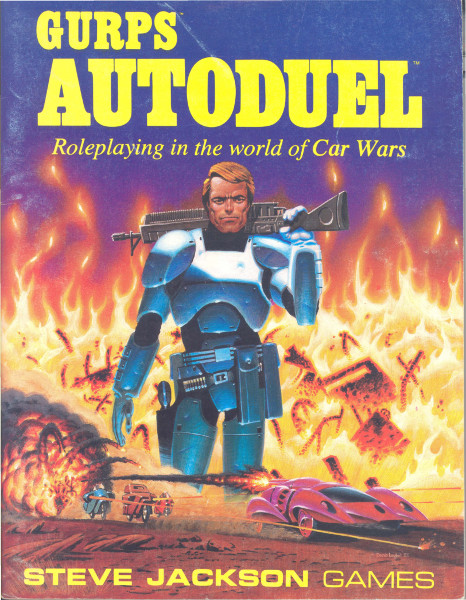
The 1990s

Car Wars was designed in the '80s, so of course, it detailed a future at the time which is now a past we'll never know. It turns out oil dried up in the 1990s, somehow. Well, it seemed inevitable at the time. The US economy went to the pits, though that's nothing compared to (undetailed) collapse of many Middle Eastern countries. Meanwhile, Britain falls into a civil war sparked by Ireland, starting the "Irish War". Beirut is nuked by unnamed, faceless terrorists, which creates increased anti-terrorism policies from countries, largely of dubious efficacy. We also get the electric car early, as well as the discovery of crude virtual reality technology. The collapse of gas results in a rise in nuclear and solar power, as well as the refinement of the electric car. Australia develops a form of ethanol based on sugar cane, while the US military turns to grain alcohol for fuel. Aircraft and air travel become a massive luxury.
Death Sports
With the sensation springing up from the (seemingly accidental) death of a pro wrestler on live TV, a craze of "death sports" emerged in America where people risked or lost their lives. Due to public pressure, these sports were eventually legalized much later, but TV stations broadcast their exploits illegally for quite some time.
GURPS Autoduel posted:
Psychologists concluded that death sports helped their audiences cope with their own deepening frustrations - with the worsening economy, with tightening government control, with the overall stress of modern living - by viewing these murderous sports and an vicariously "murdering" every obstacle in their way.
For those now considering your own new exciting death sport, this is not psychologically accurate. I'm pretty sure it's not how catharsis works (if, indeed, it works at all.)
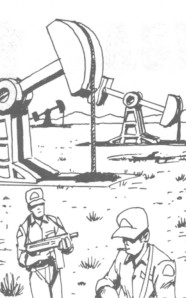
The 2000s

This is a no-man's land of history that doesn't get much focus, but I'll cover what's important in the (shockingly detailed) timeline.
The year 2000 sees the biggest event in this time period, which is the American government attempting nationalize oil reserves. Texas, Louisiana, and Oklahoma secede, and the following Second Civil War quickly turns too costly for America to pursue. California threatens succession, but federal military occupation puts the skids on that. Utah secedes under conservative religious leadership to form the Republic of Deseret, and America lets them go, having no ability to effectively fight a third Civil War. The total collapse of Mexico attracts American cycle gangs, who migrate south to loot and pillage, at least until Mexican civilian militias start to beat them back. Shootout , a capture-the-flag event using guns, is aired on sports networks until the FBI shuts it down. "Combat football", using weapons, and full-contact basketball emerge as well. Deseret, after negotiations, agrees to rejoin the US as an "autonomous region". Mexican warlords then kick the cycle gangs back to America for the most part, and a few turn to raiding each other or Texas.
Science seems to march on despite national collapse.
 Virtual reality technology develops the ability to store (if not interpret) information from the brain, while mammal cloning is perfected at Harvard. A "tragic lab accident" discovers that information from brains can be gleaned after death, though only for short periods. The first human cloning in America quickly turns to a legal battle in which it is declared human clones have full rights, with the cloners having parental responsibilities over the created clones. Meanwhile, scientists learn to fast-grow cattle clones in half the time, a big leap for industrialized farming.
Virtual reality technology develops the ability to store (if not interpret) information from the brain, while mammal cloning is perfected at Harvard. A "tragic lab accident" discovers that information from brains can be gleaned after death, though only for short periods. The first human cloning in America quickly turns to a legal battle in which it is declared human clones have full rights, with the cloners having parental responsibilities over the created clones. Meanwhile, scientists learn to fast-grow cattle clones in half the time, a big leap for industrialized farming.
The Grain Blight
With the world already in or teetering on collapse, we have the final apocalyptic spark, which is the grain blight known more often as just "the Blight". A highly virulent virus of unknown infection methods, it quickly destroys grain crops in US and Russia, and then spreads to the rest of the world rapidly. Only Australia, which effectively closes its borders to prevent infection, remains untouched. US and Russia blame each other for the Blight, and thirty minutes of nuclear exchange are sparked. However, most of the ballistic nuclear weapons are nullified by satellite defense systems, and only a comparative handful of nukes land. After a small number of impacts and about thirty minutes, both countries go to talks to prevent further disaster. While processed foods that contain preservatives are immune to the Blight, things rapidly get worse worldwide as food reserves start to run down. As "Secession Fever" continues, Quebec secedes from Canada with a brief civil war there, and Ireland obtains its independence at the end of its long war with Britain.
We're up to around 2015-2016, our present day at this point.
Next: What the future holds.
Future History
Original SA post
Part 3: Future History
Last we left off, it was 2016, and the world was falling into ruin.

After a few years of waning food supplies and massive starvation, the "Food Riots" begin, and order collapses entirely in most countries. Cities are looted while people flee to rural areas, where they conflict with locals over land. Highly organized cycle gangs, already honed from their raids across Mexico, proceed to ride in and clean house in America. Asia is hit the hardest of any continent, with flotillas crossing the Pacific to try and escape the chaos going on there. Africa and South America fragment and those continents descend into complete third-world status. Surviving farms, towns, and cities in America began to take on a fortress mentality to fight off raiders and bandits, and armed caravans began to emerge as a means of combating bandits and raiders. State governments fall apart, and local governments are left operating effectively independently. The loss of grain alcohol fuel (and its expenditure in the Second Civil War) means the US military is practically grounded, and can't effectively maintain order. While the US military is converting over to electric technology during this time, it will arrive too late to prevent the shitstorm hitting the proverbial turbine. Texans and Mexicans raid each other constantly. After a massive earthquake in LA, Northern California secedes, becoming the Free State of Northern California. Minnesota also secedes briefly before diplomatic talks bring Northern Cali and Minnesota back into the fold. Britain keeps order through severe rationing and martial law. Meanwhile, refugees from all over the world converge on Australia.
Scientists rapidly work on a way to counter the Blight, but no cure is forthcoming. Instead, the focus is put on alternative foods, and the development of "quick-grow" techniques developed for cloning make it possible to develop a fast-growing algae, which is put into production by ConTexCo, a Texan company. Meanwhile, Dr. Richard Sardusky at Harvard uses the fast-growing clone technology to clone himself, but the resulting clone is effectively mindless and he's jailed on child abuse charges. The Supreme Court eventually declares the mindless clone to be "experimental material" and Sardusky is freed and immediately hired by Amalgamated Meditech. Secret experiments at Meditech find a way to transfer stored memories from earlier technology into fast-grown clones, and they create a new division to pursue a means of practical if not literal immortality: Gold Cross. Meanwhile, the growing algae industry begins to distribute a cheap, plentiful food source.
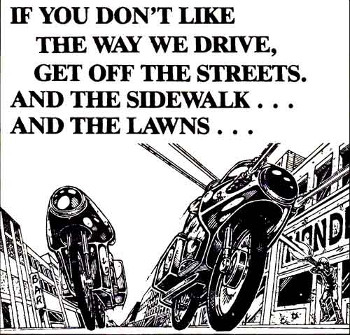
Art from Sunday Drivers .
The 2020s
With the economy slow starting to recover between the new food source and the refurbished US military, the federal government of the United States develops a mobile reorganization for the Army to reassert control over the country. Russia, on the other hand, seizes government control of any and all food supplies to enforce order. Mexico and Texas sign a peace treaty, though Mexican warlords still continue to raid other border states. Australia tries to turn back refugees while simultaneously fighting "vigilantes" trying to just slaughter or sink refugee boats. Britain confiscates all private weaponry in reaction to events across the rest of the world. US forces finally turn back Mexican warlords, who make a concerted push into California only to be driven back.
Science-wise, Gold Cross becomes massively successful, with rich people beating down their door to have clones made to cheat death. The Supreme Court rules than a clone programmed with the memories of an individual is treated as that individual, legally, but does not at the time deal with the question of a living person with a programmed clone. However, "living clones" tend to be banned locally in America nationwide as a result.
Autoduel
Death sports are legalized in America and later in Canada, giving us the birth of autoduelling when "Crazy Joe" Hershman puts a .50 caliber machinegun on his car at demolition derby. Unsurprisingly, given the writers, the first official "autoduel" is held in Austin, Texas. The Boy Scouts and other scouting organizations reform as the Scout Commando Corps, where armed young men learn to help local communities maintain order and defense. The popularity of autoduelling and the still generally chaotic nature of rural areas leads to the production of the first mass-market armed vehicles. Autoduelling, in turn, becomes America's national sport. The AADA, or American AutoDuel Association, forms as its regulatory body, and also as an analogue to the real-life AAA (American Automotive Association). Meanwhile, Australia legalizes autoduelling in more lawless regions. Autoduelling becomes a pasttime on American roads for a variety of reasons, sometimes just as the equivalent of street racing or good-natured brawling (except when somebody loses a face). The armed vehicles serve as a partial deterrent to cycle gangs, though the gangs that survive onward are the most large, experienced, and/or deadly. In New England, anti-duelling lobbies create the Eastern Driving Safety Enforcement League (EDSEL) as well as a number of anti-duelling statutes. Local autoduellist clubs form, and often serve as local defense for communities that hold them, to say nothing of armed police cars.
The 2030s
The era of roving cycle gangs in America and Canada starts to wane symbolically when the MONDOs (Midville Operatives for Neighborhood Defensive Ordinance) of Midville, Ohio fight off the reknowned gang the Crusaders using only traps and small arms, and similar local defense organizations are inspired by their heroics. Gangs are still widespread, but attacks on local communities start to die down as a constant concern.
GURPS Autoduel posted:
Car Wars , autoduelling simulation game, is released to the public; immediate hit with duelling fans, game is scorned by real-life duellists.

Autoduelling vehicles, designed for sale in other counties, are stolen by criminal organizations or by heist organizers in Britain. The British government is forced to arm police vehicles as a response. EDSEL makes a push into the Midwest only to be literally fought back by duellists in Ohio and Indiana. The RAADA (Royal Australian AutoDuel Association) is formed as a sister organization to the AADA in Australia. Meanwhile, news organizations start to include spectacular coverage of duels in their traffic coverage, which starts to actually outpace arena autoduelling. Meanwhile, part of the AADA weary of safety regulations and division rules breaks away and forms BLUD, or Big League Unlimited Duelling. BLUD chapters form, quickly demonstrating a violent rivalry with their AADA counterparts. They're the Cobra Kai to the AADA's Mr. Miyagi, if Mr. Miyagi had a nationwide sports organization's cache.
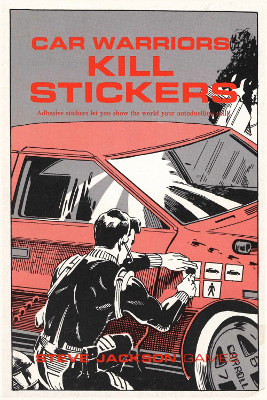
A real thing that was sold.
What happens in Europe or Japan?

And that brings us to 1986 - or 2036, as the timeline of Car Wars was always set perpetually fifty years in the future. This was notable in the equipment books known as Uncle Albert's Catalog , which were labeled by year - 2035, 2036, 2037, 2038, finally ending with the last Car Wars release, Uncle Albert's Catalog From Hell , released in 1992 but labeled as 2041. Ooops. Well, it was where the line was buried for the next decade.
Next: The 2036 Mini-Atlas of North America (European Edition)
(One half of) The (AADA) 2036 Mini-Atlas of North America (European Edition)
Original SA post
Part 4: (One half of) The (AADA) 2036 Mini-Atlas of North America (European Edition)
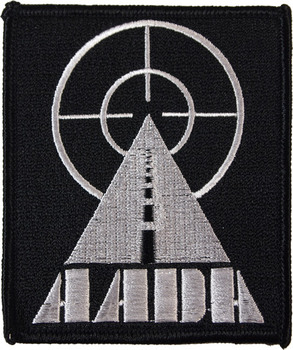
Why the European Edition?
 Presumably it's so it can go into explanations of things that would be presumed to be common knowledge in America. Not that we have any idea what's going on in Europe, so it's a little odd. We get some generalities that local laws vary widely in the setting. It's suggested that when posted, speed limits be obeyed; some police departments will fine you, others will just shoot speeders.
Presumably it's so it can go into explanations of things that would be presumed to be common knowledge in America. Not that we have any idea what's going on in Europe, so it's a little odd. We get some generalities that local laws vary widely in the setting. It's suggested that when posted, speed limits be obeyed; some police departments will fine you, others will just shoot speeders.
Armed people and vehicles - concealed or otherwise - are legal unless specifically noted, though actually using them is illegal inside city limits in most jurisdictions. Active autoduellists in a city may also be held accountable for property damage, or just shot on sight. That's a problematic tack for police to take, since it just escalates things, but the game needs its excuses for shooty shooty bang bang. It's generally considered discourteous to point your weapons at somebody unless they're approaching your home or approaching in a threatening manner. Keeping vehicular weapons trained on another vehicle is considered insulting and often a good way to trigger a duel. Some municipalities prohibit weapons entirely.
Vehicle licenses are acquired through the state police, and the United States, Canada, and the Free Oil States (Texas, Louisiana, and Oklahoma) recognize each other's licenses. Each section notes the quality of roads; some are in bad enough shape to damage tires. Some private owners maintain toll roads and charge extremely high tolls (hundreds of dollars) that maintain safety through patrols by private security.
GURPS Autoduel posted:
Don't even think about trying to bypass or crash the toll booths. This is never worked yet.

The East Coast
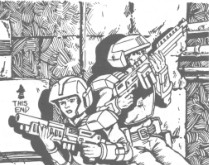
This area is probably the best-recovered area in America, and there are areas where road duelling is practically unknown. The book warns us to make sure we have winter driving and survival supplies during those months. Arms, vehicular or otherwise, require a permit in Connecticut, Delaware, New Hampshire, New York, Rhode Island, and Vermont.
- Connecticut: Probably the safest roads in the nation, but it warns that police patrol heavily and have a very low tolerance for violence.
- Delaware: Mainly notable for the Dover Downs International Speedway, a "dueltrack" which is an experimental format that combines racing and duelling.
- District of Columbia: The Government Quarters bans all weapons and unauthorized vehicles, the city itself is prosperous but unremarkable otherwise.
- Maine: Another relatively safe state, mainly due to low traffic. The guide recommends the "King Horror Haven" in Portland.
- Maryland: Baltimore residents are known for the "Baltimore Code of Honor" which seems largely to be a variety of reasons to spark duels. The local sport of "Joustduelling", where vehicles battle across opposing (and divided) lanes is popular here.
- Massachusetts: Boston is partially rebuilt, the rest in ruins, and is home to the HQ plant for Uncle Albert's Auto Stop & Gunnery Shop, the foremost civilian arms manufacturer in America. There's a warning about the Pulser and Hellrider gangs, who have a heavy presence on the roads but thankfully mostly fight one another.
- New Hampshire: Similar to Connecticut, but it warns that tourist traps are often "havens for pickpockets and confidence men".
- New Jersey: Duels are common along with poor road conditions; Newark actually survived the Food Riots by repelling refugees from New York City, and Manhattan has never forgiven Newark as a result. Street gangs in Newark are in a constant state of warfare with New York gangs, down to having armed camps at the border.
- New York: A vigilante group called Nightsword tries to combat the high bandit activity here. State attempts to control arms have been mostly fruitless. Manhattan has reemerged as a trading port and the Stock Exchange has been reformed - it bans weapons, but local gangs generally flout that law. Poughkeepsie was nuked and is now ruled by gangs that Lord Humungous would probably be proud of.
- Pennsylvania: The Transport Authority is the dominant political power here, which maintains the duelling-free turnpike, and has a license to kill duellists over any violent infraction. Allentown has become a major automotive center.
- Rhode Island: Water sporting events are popular here; save caveat as before. Open display of sidearms is frowned upon. Things are alright.
- Vermont: The guide recommends hiking, camping, and maple syrup.
- Virginia: The Blue Ridge Mountains are still a haven for cycle gangs and raiders, despite efforts to the contrary, and many areas are still entirely outside of government jurisdiction. It recommends visiting "Arlington National Cemetery, first high-rise mausoleum in the country."
- West Virginia: Largely still collapsed. Drivers are warned to stay on major roads, as otherwise the "population is reputed to be inbred and vicious". Ooookay. "White Sulphur mineral spas must be avoided at all costs." Wait, what?
It notes that Southerners love guns and hate foreigners. A region of "bucolic beauty".
- Alabama: Mostly notable for being gang-dominated; the Goremongers rule Huntsville, while the Vulcans dominate Birmingham. "Caution is advised." Roads are very poorly maintained.
- Arkansas: Duelling is very popular here. "... birthplace of AADA champions Joe and Bobby Whalen; visit their Autoduel museum, but keep your weapons loaded on the way."
- Bourbon Free State (aka Kentucky): No, not free of bourbon, quite the opposite. Instead, they kind of have a half-hearted bullshit secessionist thing going on that amounts to a lot of talk. Concealed weapons are illegal.
- Florida: Hurricanes and ensuing disease epidemics during the Food Riots period all but annihilated the tourist industry and much of the population here. Los Disneys, the former Disney Amusement Park, was converted into a high-tech arcology that fends off raids from the lawless communities that surround it.
- Georgia: Many of the poorer areas host gangs. Meanwhile, state law enforcement often hires vigilantes to try and prevent poachers on local wildlife refuges.
- Mississippi: Heavily militarized along the Louisiana border. Presumably Christian guerilla rebels mete out their "Crusade on Wheels" in rural areas. Biloxi's Mardi Gras celebration has come to rival that of New Orleans.
- North Carolina: The local tourist industry was wrecked by pollution. Meanwhile, an ongoing debate over the legality of weaponry makes committing offenses against both sides of the debate entirely too easy.
- South Carolina: Recommends sights like Charleston and the abandoned Polaris Submarine Base. Weapons are illegal without a permit.
- Tennessee: Memphis is a center of the music industry once again, and is a major algae manufacturer. The Cyclones gang, in their resplendent pink, is huge and dominates the roads, but is not particularly aggressive to lone motorists.

Known for largely being an abandoned "Badlands", with wide stretches of unoccupied land.
- The Deseret Autonomous Region: Governed by LDS (Latter-Day Saints) officials, it is largely peaceful due to heavily encouraging the self-defense of local communities and encouraging local AADA chapters. Duels tend towards the non-lethal and "fair" with surrender being respected; violations of that code are likely to go south quickly.
- Colorado: Colorado Springs was nuked, though NORAD survived. Vail offers skiing and snowmobile duelling. "Many national parks lure the tourist who lacks a sense of personal safety."
- Idaho: The panhandle is a dust bowl, but potato farming dominates the state. Local vehicles sometimes run on potato-distilled "gasohol".
- Montana: It warns that local oil wells and miners have a tendency to shoot first and ask questions never.
- Wyoming: Practically unpatrolled, "drive as fast as you like and nobody will care" outside of local towns.
Next: The other half.
(The Other Half of) The (AADA) 2036 Mini-Atlas of North America (European Edition)
Original SA post
Part 5: (The Other Half of) The (AADA) 2036 Mini-Atlas of North America (European Edition)
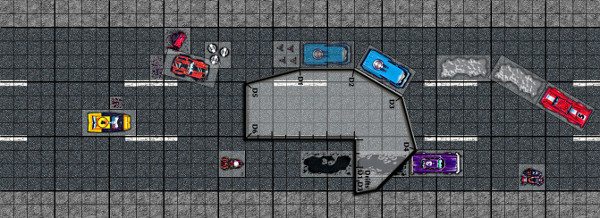
The Midwest
"... is mainly an obstacle for the traveller to get across as quickly as possible." Thanks, guys. Largely abandoned outside of the notable Fortress Cities.
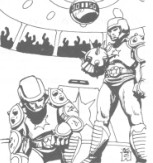
- Illinois: Chicago has become the gathering place for the new Church of America, an evangelical religion that preaches that Chicago is a holy city. It survived the Food Riots, mainly thanks to the Society of Wotija and other ethnic organizations banding together to drive out the cycle gangs.
- Indiana: EDSEL is present but weak here. Floral Gulch survived due to the local military base, and Brickyard was nuked by terrorists ("the crazed Jackson Memorial Commands") in 2013. An in-joke about Michael Jackson? I dunno.
- Iowa: It notes that the Amana colonies prohibit all weaponry, and that there have been some "Back to the Earth" communes founded near Marquette. "... despite pacifist claims, they have exhibited great enthusiasm in defending themselves."
- Kansas: Largely deserted outside of cattle herders. A lot of the western side of the state is essentially lawless.
- Michigan: Only Detroit is detailed, which is apparently a major car manufacturer (still? again?) but ridden with crime and violence, so you can get your Robocop on.
- Minnesota: The Twin Cities ban in-city duelling, and are relatively well-off despite initially being hit hard by the Blight. It also notes there are a lot of gangs in the surrounding area, though the police keep them out of the city itself.
- Missouri: Mostly returned to wilderness, though there are cattle herders, and the University of Nebraska's combat football team is much more popular than duelling here.
- North Dakota: ... gets no detail. Seriously, none.
- Ohio: There's Midville, famous for its civil defense MONDOs (as well as the setting of the Car Wars supplement Crash City).
- South Dakota: Gangs, cattle, and it recommends Badlands National Park.
- Wisconsin: "The Land of Cheese and Beer"; it recommends the German food and water sports. Er. The water sports that take place on water, that is.
The Pacific Coast
Though prosperous, this area also suffers from crime and overpopulation that come with it.
- California: Probably the most detail of any state. Fresno is the original home of raisin farmer Joseph "Crazy Joe" Harshman, the original autoduellist. Los Angeles is divided into a hundred "civic territories" each ruled over bytheir own gangs, businesses, ethnic groups, etc. San Francisco is the financial and tourism center of the West Coast. "... several samurai-code autoduel clubs, generally independent of the AADA, war amongst themselves."

- Oregon: Beautiful landscapes, poor people, oceanfront desalination plants.
- Washington: National parks, seafood, and tire chains.
The Southwest
This has a very "Old West" sort of stereotype to it due to poor governmental control and heavy cycle gang activity, matched only by the heavy state patrols; both seem equally dangerous.

- Arizona: Lots of gangs and Mexican raiders make things rough, and it recommends you pack extra water and power cells.
- Nevada: Much like Arizona, but also with a mysterious "Desert Ghost" killer that has torn open vehicles to get at the meaty people inside. Top secret fact I know from *lore*: they're referring to giant goddamn scorpions. Las Vegas waned as a gambling capital and instead has become a center for TV production. There's a cycle gang call the Saguaros that are known more for their parties and potshots than standard raiding activity.
- New Mexico: Once again, gangs and raiders are an issue, along with the general corruption of local authorities.
Alaska and Hawaii
- Alaska: Effectively run by oil companies. Roads are in bad repair and mostly vanish under the weather, and a lot of travel has to be done by (expensive) plane.
- Hawaii: Still a beautiful tourist destination. Not so big on cars shooting at each other, though.
The Free Oil States
It notes that the governments here are struggling, and though oil makes them prosperous, things are still unstable. It notes all of them can be hostile to visitors and don't have much tolerance for criminal (or perceived criminal) activity.
- Louisiana: Now a dictatorship with mandated Catholicism. New Orleans has recovered and has been rebuilt as a tourist attraction, though it's put major financial strain on the nation to do so.
- Oklahoma: Travel is rough outside of company-run toll roads. New Tulsa is a new oil town built near the old ruins of Tulsa. Cycle gangs include the Rogues (effectively mercs who work for local oil refineries) and the Outsiders (your usual thuggish bandits).
- Texas: Arlington is the largest city, known for its industry. Austin is the capital, though it also has dangerous ruins where law holds no sway. Houston is only really known for its fortified university - the rest of the city is run by savages.
Canada
Now a constitutional monarchy. Canadians prize non-lethal duels and aren't easily provoked, but it warns not to take this as a sign of cowardice or incompetence. Notable gangs intluce the Libertines (Robin Hoods) and the Jets (who are Jets for life). The RCMP runs around in armed cars trying to shoot them.
Quebec
Like Canada, only with more French. Also, they hate people who don't speak French. Sorry, Quebec! You're a nation of stereotypes.
The United Mexican States
This is run by jefes in psuedo-feudal states from their fortress towns. Some run honest communities, while others are effectively just gang strongholds.
Next: Just trying to make it one lane at a time.
Life in Autoduel America
Original SA post
Part 6: Life in Autoduel America
We're moving on from the AADA Guide with no transition into discussion of daily life in 2036. Jobs are in short supply, and unemployment is at "30%", which is a bit of a ridiculously high number, but at least conceivable if most of America has effectively become third-world. However, it notes that most of those unemployed are apparently on the ol' dole, which results in heavy taxes. The doesn't make a world of sense, because it doesn't seem the infrastructure to really enforce taxation - or distribute unemployement benefits - is widespread. Ultimately, the purpose of this is to show the appeal of being willing to make big bucks in arena bloodsports, but it doesn't quite follow.
This gives a surprisingly minor penalty to job rolls (-1) and we get the big jobs table that came with every GURPS book of this period, now with exciting rules like payment fluctating for independent work! I can see this mattering for some games, like truckers or corporate troubleshooters, but it's a lot of detail considering many PCs (that is, the titular autoduellists) will be living off of endorsements and prize money, not paychecks.

Regular and satellite radio are a big deal, on account of the generally wrecked infrastruction. "Watching TV is the sole occupation of the vast majority of America's unemployed". Action series (like action-trucker series McDade) are popular along with sitcoms, along with sports like autoduelling and combat football. There's also a heavy following on "nostalgia TV" of ancient reruns. Small businesses run "micro booths" which charge a quaint $2 per minute for VR sessions, which are usually played in 10 to 30 minute chunks, and that allow you to save your session for longer serials. It's a quaint notion that people would be playing $60 for a half-hour in the days of 80-hour AAA games, but then I look to the whales of the mobile market and shrug. Guess it's possible.
GURPS Autoduel posted:
WARNING: The US Surgeon General has determined that playing Micros in sessions of longer than thirty minutes is harmful to your mental health.
Widespread piracy of magazines and fiction on computer bulletin board systems has effectively ended the publishing industry, and new fiction or 'zines are published as a cottage industry. Of course, Autoduel doesn't anticipate the web or widespread internet access in general, so people are still dialing in on their modems and Gophering up some files, presumably.
Travel for tourism is "almost dead" (which seems to contradict the talk of tourism in the AADA Guide), and travel is mostly done by personal vehicle, "busnought", blimps (popular because of the low fuel costs), passenger ships, and helicopters. Rail is dead outside of local lines in cities. Most planes are around but are far rarer now due to their gas-guzzling ways, with jets typically being the province of the military.
The post office is dead, with "Elmay", or electronic mail, taking over in its stead. Yes, this is before "E-Mail" was in proper parlance. Even if you don't have a computer, most towns will have a public Elmay station. Couriers transport physical goods.
A lot of people in autoduelling, civil defense, or other paramilitary groups take up "street names", which are typically things that make you sound cooler or adjectives added to your name, like Crazy Joe or Laserburn. Trophy-taking is common after a fight as well in America, like hood ornaments or license plates.
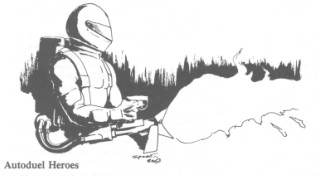
I do like the statement of intent here, which is a bit rare for a game of this age...
GURPS Autoduel posted:
The world of the 2030s may seem a grim place, but remember - your characters are NOT the people who stand in the welfare lines, collecting their checks, buying simulated food, watching their TVs, and living lives of quiet desperation.
One person with a goal and a willingness to risk his life can change history ... make a fortune ... topple empires (and raise them!) ... or die pursuing a hopeless quest.
Your character is such a person, willing to face the guns and rockets of outrageous fortune in order to live his own life. That's what GURPS Autoduel is all about - adventure in a world where people are classified as doers or watchers.
GURPS Autoduel is a campaign for doers. Welcome to their ranks.
... but also having the implication that poor people remain in their place because they just sit on their butts is... well, with America leaning towards being a corrupt socialist state of sorts, it's odd. And Car Wars is something of a libertarian dream, where the proliferation of arms and a few good local vigilantes is what pulls society back from collapse rather than the more likely turn of throwing it into a tailspin. But at the same time, it was part of the zeitgeist in the '80s that society was at risk becoming a culture of welfare vidiots, so it's hard to paint too broadly with a modern brush.

Next: All about the fella behind the windshield.
The Autoduellist (and Friends)
Original SA post
Part 7: The Autoduellist (and Friends)
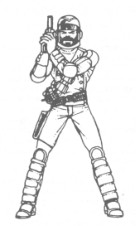
GURPS Autoduel characters are built as standard GURPS characters of their time, with the default 100 points. As is standard, we get some suggestions:
- Arena Duellist: A professional autoduellist.
- Legitmate Road Duellist: Where "legitimate" means "vigilante" or a driver in a rough enough area or line of work that self-defense is common. Like pizza delivery.
- Outlaw Road Duellist: Where "outlaw" means "bandit", or a member of Big League Unlimited Duelling (aka BLUD). We'll get to the latter later.
- Trucker: Either employed by a company, or a "gypsy" - that is, an independent trucker. (That's actual trucker slang from the time, not a pejorative.)
- Cycle Outlaw: A stereotypical road thug, though some might be more upstanding depending on the gang.
- Mechanic: As it says on the tin. Skilled and honest mechanics tend to get a lot of support from duellist community. Strange note: suggests picking up the Mace skill to swing a wrench with.
- Police or Ranger: Where the latter is a Texas Ranger.
- Commando Scout: Like a Boy Scout, but also trained in civil defense. It gives a cap to points spent on skills based on age, but I don't remember if that was a mainstream GURPS rule.
- Militiaman: Local civil defense, like the MONDOs.
- Investigator: PI, peace officer, or investigative reporter.
- Cameraman: "Most cameramen will also have some combat skills, as they go in harm's way!"

I'm not going to explain every advantage and disadvantage, but they should be self-explanatory.
Bizarrely, they list Autoduel as a "low mana" world with no mana in some areas, which means magic is very hard, but possible. This doesn't make a lot of sense, and I'm not sure why it was done, since magic will barely be mentioned otherwise. Though there are later articles in Autoduel Quarterly for "Dragons in Car Wars" and "Magic in Car Wars", they're extremely tongue-in-cheek and unofficial.
It notes duellists can take sponsors in the form of the Patron advantage, and fame is done through Reputation. Oddly, they allow the GM to grant players temporary reputation for free (like being publicized due to a road duel), but if PCs don't back up their points-paid, fame-based Reputations by getting media attention, it can fade away at no compensation to the player. Dick move, Autoduel. Status generally represents government or corporate positions. Starting Wealth is $5K, which is supposedly "enough to outfit a small vehicle", but honestly is the bare minimum you'd need to build a car on. Ideally you want at least $10K-$15K, like, you know, a real car. Given that it's called GURPS Autoduel, it'd be nice to be able to buy more than a "1st-level" car without having to be wealthy, but alas.
It notes that Illiterate people will have a hard time with some signs and maps. "Proles" and "weffies" - those that live on welfare - get a minor Social Stigma. Outlaws, like biker gangs and bandits, have a much more severe Social Stigma.
GURPS Autoduel emphasizes that GURPS skills require specialization (like you don't just know guns, you have Guns (pistols) or whatever), but also gives an additional (small, -1) penalty to driving a new type of car or vehicle until you're familiar with it. By type of car, thankfully, it doesn't mean a specific vehicle - it means driving a van when you're used to sedans, for example. How this is actually tracked is somewhat vague. It gets heavy into the differentiation of the different types of vehicles, but I'll skip that. Notable bits: Battlesuit is useless, as battlesuits don't explicitly exist (though come to think, all the technology necessary to make one seems to be present). It notes that archaic weapon skills are more common than in modern day due to the prevalence of things like professional gladiatorial fighting. Parachuting is used for ejection seats. There's also the Electronics and Area Knowledge skills added in this game that would be incorporated into future editions of the core rules.
Personal Equipment
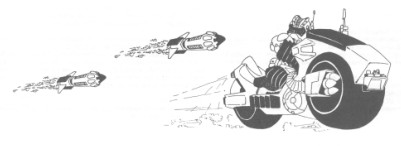
We get the requisite list of personal guns, many of which are just real weapons or have obvious real-life analogues (M-26A2, AK-13, Uzi). It also has a few oddities born of the Car Wars game. Grenades come in frag, tear gas, smoke, concussion, but also paint (to obscure helmets and windshields). There's limpet mines that are basically mass-produced shaped charges. There are a few vehicular weapons on tripods (like a recoilless rifle or machine gun). It requires a power pack, but there's a laser rifle. And no doubt thanks to the Road Warrior, there's a "MiniCrossbow". There's also special rules for "Cheap" weapons - lower cost, but gives a small penalty to hit.
In addition to your usual flak and kevlar vests, there's also the iconic body armor and improved body armor of Car Wars, which honestly don't provide much protection considering the amount of damage dealt out by guns, but it's certainly better than the unarmored alternative. There's also special suits to ward off fire and lasers. Trying to ward off lasers is a bit hilarious, though, since most of those are vehicular and will burn right through your dorky little suit.
We also get weapon accessories, tools, electronics, survival gear, etc. About the only bit of note is that computers store information on half-pound "computer cubes", and computers themselves can do things like download the newspaper, shop, send Elmays, etc. There's also apparently smaller computers that are plugged into public terminals and run off of that connection ("as common as public phones" - well, not anymore).
Sample Character
Finally, we get a sample character, Douglas "Crusher" Kern, an ex-commando scout turned big rig gunner for the Brotherhood of Truckers. He's hoping to buy his own rig, and is willing to take high risks to do it. Named "Crusher" because he likes to ram lighter targets with his vehicles, and also because he knows board-chopping karate. He's a decent guy looking for the next big score. I won't go over his actual numbers, because it's a pretty standard well-rounded GURPS build, and nothing particularly unusual. We can move on to something more important than people.
Cars.

Next: Before GURPS Vehicles, GURPS had vehicles, small "v".
Autoduelling
Original SA post
Part 8: Autoduelling
Many years before GURPS Vehicles terrified gamers and became infamous for its heavy math put in the service of making everything from steamboats to star cruisers, this book managed to its own vehicle design system in fourteen pages, covering cars, bikes, trikes, and tractor-trailers. How? Well, mostly just by adapting the existing Car Wars design rules to GURPS. As such, it openly admits the vehicle design rules aren't realistic, but are designed for ease of use and ease of conversion from Car Wars.
GURPS Autoduel posted:
Just pretend you're Lee Iacocca, and away we go...
Who?

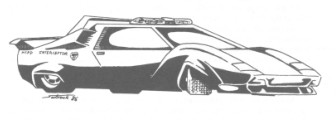
Vehicle design is still mathy, but is much simpler than later GURPS implementations. You pick your vehicle's body type (compact, heavy cycle, sleeper cabover, etc.). This determines your maximum load (weight) and cubic feet (space) to put in the rest of your components. You can spend extra money on the chassis to allow it to carry more weight, and / or the suspension to improve its handling (and get a bonus on your driving skill) or to adapt a vehicle to drive off-road. Then you take your power plant, which can improve your top speed and acceleration, but the bigger it is, the more it costs and weighs. Unlike later versions of Car Wars, vehicles have a ultra-simplified 80 MPH to 100 MPH top speed, though accessories can improve that. Next comes tires, where you're trading weight and cost against durability. Lastly, you can streamline your vehicle for improved speed but reduced space.
Armor sees the most major change from Car Wars. In Car Wars, buying armor just effectively adds more hit points to the side of the vehicle you assign it to. In GURPS, though, armor reduces damage (with a small chance to cancel it entirely) instead. This means there's a sharper difference between a car and a tractor-trailer rig or even a subcompact and a van, just because it's easier to create vehicles that can take damage indefinitely instead of being whittled down. However, it also means whenever you do take damage, something's getting busted. In any case, there's several variant types of armor: fireproof (not proof against fire damage, but won't ignite), laser-reflective (reduces laser damage), honeycombed (increases damage resistance, reduces chance of attacks deflecting entirely), surface-hardened (the reverse of honeycombed), and sloped (reduces space, but increases the deflection factor).
Weapons includes a variety from Car Wars, mainly in several categories: machineguns, rockets, flamethrowers, shells, lasers, dropped weapons (oil, flaming oil, mines, spikes), gas weapons (smoke and paint clouds), grenade launchers, and gauss guns (flechette rail weapons).
Accessories includes things like ejection seats, fire extinguishers, radar, ram plates, targeting computers, turrets. Once again, all from car wars.
Once you're out of money, weight, and / or space, your car is done. It requires addition and subtraction, but is based on early Car Wars rules, so it doesn't have any of the complex top speed or armor equations later versions of the game have.
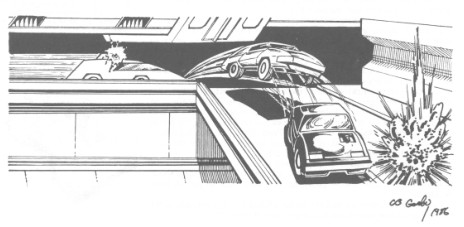
Sample Vehicles
There are a number of Car Wars vehicles converted to GURPS, which it openly admits is more of a starting point than any sort of definitive list. we have:
Notable cars include the Joseph Special, with a machinegun and a paint spray on the right side for drive-bys. There's the iconic Piranha with machineguns pointing from every orifice except for the rocket launcher in front. The Foxbat has a stealth mode, a cybernetic targeting helmet, radar and infrared, and a gauss gun as well as a vulcan (gatling) gun and comes in at an appalling $80K. The Vigilante is a powerhouse pickup with very heavy armor and machineguns. The worst of them all is the Torch, which is overloaded with flamethrowers or rockets pointing in every direction, but has armor so thin you could literally penetrate it with a .22 rifle - or a good hard kick, if you're modestly strong.
Note, of course, that none of these can be purchased with starting wealth. Which means if you don't buy a wealth advantage, you literally have to make your own car. Whups, that's a bit of an oversight.
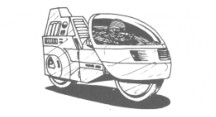
There are also a number of motorcycle designs, which mostly vary from the heavy Outlander with its machinegun and solid armor to the RoadMiser, which is literally just an unarmored light cycle. Most have laughable armor, which is a side effect of going from Car Wars to GURPS Autoduel - having a little bit of damage reduction just isn't that worthwhile. We also get trikes, like the alpha-striking Leo loaded with heavy one-shot rockets and (once again) laughable armor, and the Vapor Trail, which fires rockets in every direction and is armored well enough to compete with cars in its price class.
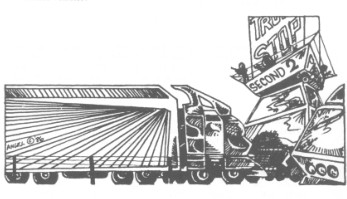
Only one truck cab for a big rig is listed, the Roughrider, with combination of recoilless rifle, matching machineguns, and very heavy armor in front (handy for rams). We also get details on a variety of trailers - flatbeds, reefers (refrigerated), tankers, dumpers, and van trailers. One bus is listed, the Commando, which is one of the most heavily armed vehicles with four recoilless rifles between two turrets, and can have dozens of armed passengers poking their pistols and rifles out besides... just don't tell the passengers that it's only lightly armored.
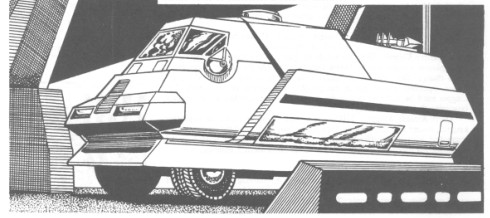
Overall, the vehicle design is pretty simple if you don't mind a bit of serious addition and subtraction. The biggest issues is that if you're doing conversions, the values for things like space and armor are just different enough that you have to do all the math for each Car Wars vehicle over again, and adjust it. Furthermore, the way armor works in GURPS drastically changes how combat works - cycles become even more vulnerable than they were before (and they were already pretty vulnerable), and sets of light weapons (like the popular double machineguns) become drastically less useful. A more subtle issue is that some modifiers are ported directly from Car Wars - like the +1 to Gunner skill from a targeting computer - even though Car Wars uses 2d6 for resolution and GURPS uses 3d6 for resolution. Often the problem is that the conversions from Car Wars are done in a straightforward fashion, even though the tactical utility of a weapon or accessory can shift notably.
Next: Driving 101.
Autoduelling in Motion
Original SA post
Part 9: Autoduelling in Motion
Vehicle Movement
The first thing that's done away with for the vehicle rules is the phased movement from Car Wars. And though that's a logical simplication - the phased, simultaneous movement of Car Wars slows the game down demonstrably - you end up with some weird Murphy's Rules because of it. For example, with two cars going a steady 60 MPH down a straight highway, one can ram the other by the driver gaining the initiative, even though they're going the same speed.
Another change that's acknowledged is that changing the scale to GURPS scale also has issues. In Car Wars, a vehicle counter is 1" long, and a car going 60 MPH will go 6" as a result. In GURPS scale, the size of a car ends up being 5" long, and a car going 60 MPH will go 30 hexes, or 30". Obviously few tables will be able to contain a map of the size necessary have cars driving traveling at that speed, unless you're willing to play on the floor. As such, it recommends that vehicles use the Car Wars scale, but everything included in this set is at the GURPS scale, and you'll have to buy Car Wars to use the smaller scale... though I suppose if you have GURPS Autoduel, the chances of you not having Car Wars are slim.
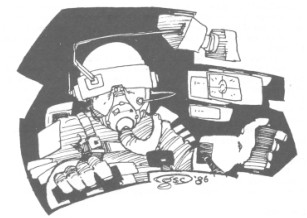
Like later versions of Car Wars, this includes a "turning key", a piece of cardboard containing various angles to steer your car with and make the resulting turn. Now, in Car Wars you're expending a resource you have each turn called "Handling Class", and when it's spent, you have to make a random roll to maintain control. However, in GURPS it just has you make skill rolls whenever you make a turn or encounter a hazard. A hazard can be debris in the road, an oil slick from an oil jet or the impact of getting hit with a rocket, while a turn is literally any turn. This means unlike Car Wars, you're rolling way, way more often, which gives a lot of chances to lose control. Granted, due to the 3d6 curve, you're not as likely to lose control given decent skill (and it's likely to only be minor, like a skid or fishtail). Still, it's a lot of bookkeeping and rolling. In addition, because of the 3d6 curve, you have weird Murphy's Rule effects. For example, at certain skill levels, taking a slow 15 degree turn over three seconds can be more dangerous than taking a sharp 45 degree turn over one second. It also gives the Murphy's Rules that ordinary drivers should be used to skidding and fishtailing regularly, since it'll be happening to them every third turn or so.
That all being said, because Driver skill plays a larger part in manuevering - the amount you fail the skill roll by determines the range of control loss you suffer - GURPS drivers are much less likely to suddenly send their car into a spinout or vaulting roll like Car Wars drivers might. Thankfully, most vehicles give a bonus to Driver rolls.

Oh, and as a taste of the kind of things I won't bore you with:
GURPS Autoduel posted:
To maneuver with a trailer, first move the tractor in a normal fashion, using the turning key or any other method. Then, move the trailer counter as follows:
First, move the trailer in a straight line along its long axis the same distance the tractor moved - if the tractor moved one inch, the trailer moves straight ahead one inch.
Second, hold down the rear corner of the trailer on the side the tractor moved toward. (If the tractor turned or drifted right, hold down the right rear corner.) Then pivot the trailer until its kingpin is as close as possible to the fifth wheel of the tractor.
Third, move the trailer (usually forward 1/8" to 1/4") until the kingpin is exactly over the fifth wheel again.
Yeah, we can skip that kind of stuff.
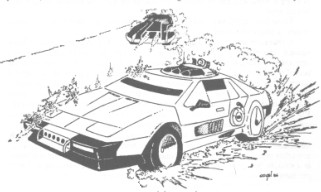
We have rules for collisions, which are even deadlier than before, probably too much so - a tractor-trailer ramming a subcompact head-on at 40 MPH will tear both vehicles to smithereens. The subcompact gets it worse, of course, but the difference is academic to our dead truck driver. This is, of course, because of the way armor works (or rather, doesn't work) in GURPS. Any hit over 30-40 MPH is likely to wreck a vehicle, which first seems realistic, but when you realize these vehicles are supposed to be heavily armored death machines, it doesn't quite work. Personal injury is also inevitable, and 60 MPH, generally lethal.
Now, ram plates reverse this situation, making rams not only survivable but preferable, halving the damage taken and doubling the damage dealt. Early on in Car Wars competitive history (there was a tournament scene), dedicated ram cars became a dominant strategy that were later nerfed, but they're still in the winners circle here. If you're looking to build the nastiest duel car, just aim for high acceleration and a ram plate - just don't go trying to ram any buses.
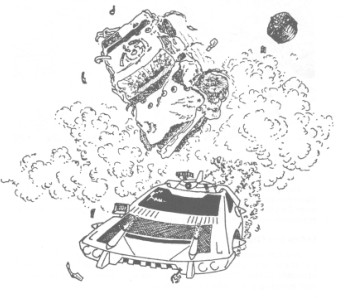
A lot of Car Wars rules are translated faithfully, and for all its professions for trying to remain simple, GURPS Autoduel can get quite complicated. From tracking debris and obstacles left behind by damaged cars to damage resistance being slowly whittled down by attacks to tracking sustained fire aiming, there's a lot to juggle. There's also having your car set on fire vs fire extinguishers, penalties from paint or smoke, tire-busting spikes, mines (really deadly compared to their Car Wars counterparts), etc.
Combat is potentially fairly deadly - most mid-range weapons do around 4d6-5d6 dice of damage, and most vehicles have armor in the 8-18 range. Unless you're aiming (at penalty) at an external target like a tire or turret, any damage that blows through is then allocated randomly to a component. The crew is a likely target on the chart, though, so make sure you bring a few "friends" when driving to see who takes the random hit. The psychopathic amongst you may want to pack your back seats with babies, since they presumably take up less weight and space, and the little ones can take those recoilless rifle shells you'd rather not have sharing space with your head. Just make sure to pack earplugs - babies can be rather upset at the sound of rockets impacting the passenger side door.
GURPS Autoduel posted:
The Vehicular Damage Allocation Table should be sufficient for most vehicle types, namely cars, trikes, motorcycles, and tractors. Characters attacking motorcycles may find a number of "hits" passing through the cycle and doing no damage ... but that's reality.
Is it? I'm pretty sure that's not... but cycles are a bit shit and could use the accidental help.
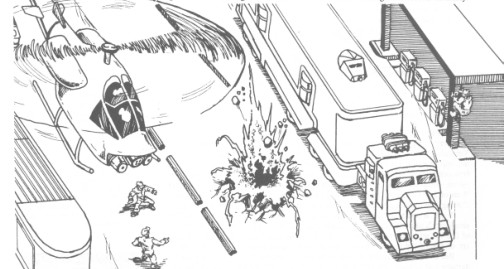
We get detailed repair rules, rules for shooting / smashing buildings, salvaging parts, cover for cars, full weapon rules for each weapon, spraying an area with bullets (this is before GURPS had detailed automatic weapons rules), blowthrough rules (a max damage players can take from weapons), explosions, and of course we would be remiss in the era of gaming without special critical hit and critical miss tables for vehicles and modern weapons to occasionally end a PC's career with an unlucky roll. We also get rough conversion rules for Car Wars characters, and wrap up the vehicle rules here.
Next: Driving the Game
The Autoduel Adventure
Original SA post
Part 10: The Autoduel Adventure
GURPS Autoduel posted:
Note to Players: This is a GM-Only section. If you are not planning to gamemaster a GURPS Autoduel campaign, do not read the following section.
Yeah, players! Get out! You may have bought this book, but this is off limits! In any case, this is where we get into campaign ideas, as well as some of the more entertaining groups in GURPS Autoduel. They also recommend you get a road atlas, a U.S. almanac (do they still make these?), and buy Autoduel Quarterly ("It's not absolutely essential... But it couldn't hurt...").
Campaign Types
- Clubhouse Blues: This is where you're part of the same AADA chapter, Scout Commando troop, police department, "or even EDSEL", with characters taking on specific roles or positions.
- Lone Wolf: For a campaign for one or two players playing tough folks who have to make it outside of civilization "for some reason".
Geez, don't hold back, say how you really feel.GURPS Autoduel posted:
Many players really, really like to play psychologically aberrant tough-guy loners, and this campaign is ideal for that sort of player.
- The Western: Take a large, tough town with weak authority, insert some standard western stories. Stagecoach is a bus or big rig, range wars become corporate wars, gangs are on cycles now, etc.
- Making a Living: Mercenaries, in other words, whether bodyguards, duellists, or "other road-jocks". Strangely, the idea of doing a truck crew isn't mentioned.
- On the Duel Circuit: And here I thought they were never going to get around to "Autoduelling". This is going around from arena to arena in competition, with a fair amount of peripheral drama on the side.

Campaign Setting
And now it's time to talk about campaign setting - they suggest taking a local town or city, or one you like, and going through the major events, like the oil shortages or the Food Riots - and imagining how that impacted things. Alternately, there were longer-form city writeups being done in Autoduel Quarterly, often by fans writing up their local towns. It also notes generously if you want to muck with the descriptions in the road atlas or elsewhere, you can.
Campaign Activities
Obviously, the main focus is for the game to act as a vehicle (so to speak) for car combat. But it notes that just having Car Wars with a cooking skill, and encourages GMs to find things that can't always be solved with a ram plate, such as:
- Self-Improvement: Finding ways to make the world a better place, and encouraging PCs to make larger plans. I'm not sure that's just self-improvement, but wh'ev.
- Intrigue and Mystery: Obviously, it's often hard to get answers with guns alone, but of course, once the mystery is discovered you can have a big vehicular confrontation.
- Stealth and Infiltration: Plots that require subtlety may discourage use of the big rig in every scene.
Campaign Adventure
It notes you can use the included adventure, but also gives guidelines on creating adventures, which... actually isn't so far from what I'd expect for a general GMing guide. Give the PCs a goal, add some obstacles (which it also terms "encounters"), then try and give the PCs either a reward or personal involvement to motivate them. It refers us back to the GURPS Basic Set for more advice.
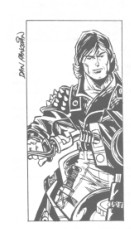
Character Death
It notes that there are some special considerations for death in GURPS Autoduel. First, it notes that though thematically life is cheap, it shouldn't be cheap for the PCs. Given the availability of arms, the logical thing for a bad guy to do is catch a player unaware with a sniper rifle or tank gun. Interestingly enough (for when this is written), it notes that it's better to take the cinematic approach, where the PC gets a daring escape from danger and a reason to get back at the villain. It reemphasizes when characters die, it should be dramatic and climactic.
The second note is - well, remember Gold Cross from the world history? Well, they're not some background element PCs can't touch. Characters with enough money can buy a clone from Gold Cross, have their memories backed up, and if not avoid death, at least negate it as a narrative concern. However, there's some limitations, including:
- It takes $10,000 to grow the initial clone. This takes six weeks. After that, it takes $1,000 a month to maintain.
- At any time, you can go and program your clone with your current memories for $2,000. These memories fade after a month if not maintained.
- Alternately, you can pay $25,000 to buy storage space on a MMSD (Mechanical Memory Storage Device). This maintains your stored memories indefinitely. With this, you can pay $5,000 to have them ready to grow a new clone as needed.
- You can also pay $5,000 to have them read your memories from your corpse; this is possible if the body is less than a day old (ten days if the body is kept on ice). However, there is a likelihood of acquiring a Phobia relating to the trauma of death.
- Here's the worst: you lose all experience since the last memory recording. Though I suppose this has verisimilitude, it seems unnecessarily dickish to mess around with an OOC currency (though I suppose games at this time didn't make that distinction).
GURPS Autoduel posted:
... you can occasionally put real fear into a character with some non-damaging nastiness. Imagine getting this phone call five minutes before you're to go into a death-duel with your Enemy: "Mr. Cutter? This is Gold Cross, Columbus. Can you come into our facility in the next day or two? I'm afraid your clone's been terminated ... some sort of foul-up in the nutrient mix. We'll replace it at no charge, of course, but we need to get your current memories in an MMSD..."
Ah, playing dirty, I see.

And once again, it emphasizes potential loss of memories and the six month growth time. In a later section, it notes those who die in a professional duel can't place amongst the winner, even if they would normally points-wise and have a back-up clone ready.
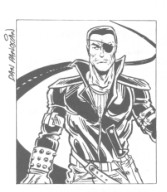
Encounters
While in other games this would be a monster section, this is actually more about the in-game factions of Autoduel America.
- The American Autoduel Association (AADA): An organization that serves chiefly as a sporting organization, it approves arenas based on safety (to the audience and duellists) and fairness (to the duellists). They also place limitations on legal car designs to ensure competition, have "divisions" based on car price, and take fees on broadcasting to support the organization. There's a lot of detail on how tournaments are done (and the full season listing, and the circuit regins, and so on) for those looking to play it out. The AADA also provides membership for the everyday driver, along with their own road atlases and information services, as well as their quarterly publication. Despite the name, the AADA has become international, and has offices from Finland to "PanArabia".
- Anarchist Relief Front: This is a loosely-organized group of anarchist terrorists seeking to overthrow the US government (and any other, but they're mostly US-based) though violent nonsense. "While the idea is not entirely without merit..." Oh, you shine on, you crazy libertarian writers. Well, I don't know they're libertarian, but I have a feeling with comments like that. (Steve Jackson is, if nothing else.) They're nuts who can be used as all-purpose purpose-less baddies.
- Big League Unlimited Duelling: While their origins are unclear, BLUD seems to be a reaction to the AADA born out originally out of the Midwest region. BLUD isn't organized per se; instead, it's a label that small chapters form under. "Professional" BLUD duels, when they occur, are illegal anything-goes bloodbaths. Naturally, they're directly opposed to the AADA, and vice versa.
- Scout Commando Corps: Born from various earlier scouting organizations, the SCC helps local communities against disasters, raids, and to fend off criminal activity. The minimum age is 13 and they're retired from the organization at 18, but it emphasizes that troops are a genuine paramilitary force at this point. Yay, romanticized child soldiers!
- The United Broadcast Network: One of the largest networks around after only 15 years, they made their name on seeking out and covering vehicle combat, particularly road duels. Their helicopters seek out road violence, often airing it live. Naturally, this can have an impact on one's reputation, particularly for those performing "unsportsmanlike" conduct, like firing on a notably weaker vehicle, attacking uninvolved civilians, or firing on a fleeing target. Alternately, some duelling careers have started based on the fame gained by a UBN broadcast.
- The Brotherhood: When the government pressed the trucking unions to keep punishing runs going during the Food Riots, a number of truckers, after years of fighting cyclists and bandits, went on strike. When the military tried to break the strike, it turned into a full-scale battle. Though there were no winners that day, the leader of the strike, "Mongo" McGuire, would die declaring that a "Brotherhood" of truckers would be formed. Inspired by his actions, the Brotherhood was formed, led loosely by the "Knights of the Brotherhood" - a few truckers with enough money and clout to fight for the interests of truckers, sometimes literally. They can also declare somebody an enemy of the Brotherhood, which is practically a death warrant on the open road.
- The Eastern Driving Safety Enforcement League (EDSEL): Largely an East Coast organization, EDSEL discourages road combat through both lobbying and also highly-armed patrols of cars that drive around and attack active road duellists. Later on (in the AADA Guide), EDSEL will become famous for using helicopters instead of just cars, since few cars are designed with anti-aircraft capability. And no, the notion that the anti-gun lobbyists of GURPS Autoduel are intolerant, murderous hypocrites isn't lost on me.
- Cycle Gangs: It notes that the cycle gangs that have survived to 2036 are probably the toughest, largest, and most sophisticated gangs. We get two examples: The War Dogs, who are your stereotypical thugs, driving cheap bikes and still raiding towns and taking prisoners and slaves. (And yes, rape. This has been Rapewatch, noting rape in your tabletop games since 2016.) Their moral counterparts are the Paladins, who have a medieval theme and make their living off of vigilante mercenary work, raiding other gangs, or holding renfaires with bike tricks.
https://www.youtube.com/watch?v=I3q0iHYVjBA
Yeah, like that.
- Citizens' Militia: This, of course, refers to local paramilitary organizations, but mostly this book wants to talk about the MONDOs. See, the MONDOs are the heroes of one of the first Car Wars supplements, Crash City, where there were a variety of scenarios where a large, feared cycle gang known as the Crusaders tries to raid the city of Midville. "Historically", though, they're fought off by the group known as the MONDOs with their pluck and guerilla tactics. There's a lot more to it than that, but there's not a lot much more to say unless you really enjoyed Crash City or its sequel, Sunday Drivers.
- The Police: This can apply to the stereotype of the honest officer, the corrupt thug, or corporate security forces of one sort or another. There aren't many surprises here, really, other than them being more likely to hire freelancers (i.e. PCs) as a sort of freelance police. I wonder where I've heard that before...
And we're almost wrapped up.
Next: Have an adventure.
Adventures
Original SA post
Part 11: Adventures
GURPS Autoduel posted:
NOTE TO PLAYERS: This section is for GMs only; it contains sample adventures. If you aren't planning to gamemaster a GURPS AUTODUEL campaign, do not read the following section.
Yeah, players, this is a GM-only klubhouse!
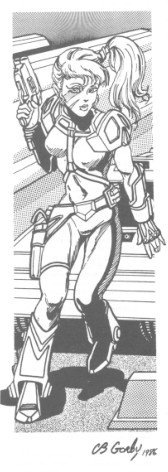
Amateur Night
So, Amateur Night is the traditional starting Car Wars scenario. The idea is that drivers without cars can sign up for amateur night at the local autoduelling arena and are provided with cheap cars ("armed tin-foil wonders"). The winner gets to keep their car, and the surviving losers go home. Losers can try again twice more, but if you fail three times, you strike out, no more Amateur Night for you.
It goes into that waviers have to be signed, the ready room. For some reason, it notes that amateur nights have a minimum of four contestants, so any empty slot should be filled with an NPC. We get one sample NPC for use, a chauvinist white-supremacist jockheel by the name of Wade Brogden, who seems intended solely to provide reasons for the PCs to shoot him. PCs get the "Sargasso XL", a dull little number with decent armor that fires micro-missiles (not to be confused with the mini-missiles from a certain other game line). They also include the Bakersfield Amateur Autoduel Arena with a map to copy - it was presumed back in those days you'd have a bunch of graph paper to do that on. But-
GURPS Autoduel posted:
When redrawing this map, you can make it as big as you like! Just keep the proportions roughly the same, and you'll be ready to go!
- that's not helpful.
What next? A plot twist? No, the adventure warns against having plot twists like sabotage or the like. Instead, it wants a fair fight. Because this is now a PC PvP free-for-all. It's weird to look back at, since it's very possible (if not likely) that another PC could off another PC just by accident, unless everybody's going around just trying to shoot tires off. After the fight, medics will treat any injuries and the winner can keep their car or sell it back to the arena for money. It suggests having the usual post-game show chatter between the winner, and possibly temporary Reputation if they did well.
And then the PCs are on to their next adventure, even though they're not connected and just tried to kill each other. This is the kind of thing that makes sense for the board game version, since it's a good way to learn the game with simple, cheap cars that make for a fast session. But for GURPS Autoduel, it's a bit lacking. Thankfully, we have at least one other adventure.
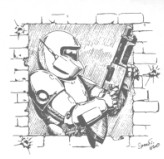
Four on the Floor
This is an adventure intended for PCs with some experience and probably their own vehicles. A town - one it suggest the GM set as connected to at least on of the PCs - is being menaced by a group of raiders "Four on the Floor" who have been riding into town, attacking, looting, and then fleeing. The PCs will be hired by a man named Boyd Biggs who offers $60K (his life savings) to deal with Four on the Floor. He'll give them the royal treatment, a good room and hotel, while they come up with a plan to help defend the town. The locals will help out, but they mainly have just handguns and unarmed cars.
The fight itself is loose and notes how it should be run depends on the PC's defense plans, because somehow Four on the Floor is privy to their plans and will attack wherever defenses are weakest, and flee at any sign of a proper defense. Then, they escape over a bridge that collapses (somehow, it's not explained) as soon as they're over.
GURPS Autoduel posted:
In short, contrive things so that the bad guys get away; unless the PCs (or players) are idiots, they will realize that Four on the Floor knew precisely what to expect when entering the town.
The players are free to come up with new plans and fend off any future assaults, but Four on the Floor will always be privy to their plans. See, it turns out they've been bugged (without any chance to notice, apparently). The PCs have to figure out they're bugged, but it doesn't really give any guidelines as to how they manage that. There's a random roll for PCs (7 or less on 3d6) to recognize Boyd Biggs' reputation as a former sports promoter. Further research can find out that Biggs is wealthy - too wealth to count $60K as a life savings, and that he probably arranged to have a wrestling match end in death. Those who remember the first part of this review might remember the wrestling death that triggered the blood sport craze, and this is that. During the trial that followed, Biggs turned out to be criminally insane, and was institutionalized for a time before getting out. He's a crazy guy who likes to set up bloody battles and find a good place to watch.
The best plan - because this adventure pretty well dictates this - is for the adventurers to use the bugs to lure Four in the Floor into an ambush. If they destroy the bugs, Four on the Floor will attack very cautiously as a result. Either way, they'll eventually have to uncover the gang's HQ and finish them off, though an ambush will help thin their numbers considerably. They can either capture and interrogate a member, or do a painstaking search. (Since Four on the Floor uses off-road vehicles, it doesn't seem like they'd be hard to track, but I digress.) When they get there and beat Four on the Floor, they'll find out that the group wasn't just bandits - they were hired mercs. However, Four on the Floor was hired by courier - they don't know their employer.
Biggs can be outed through the above information, and also the base Four on the Floor was operating out of is on land Biggs owns. It also gives PCs a tough Psychology roll to try and puzzle out his mental tics as well.
GURPS Autoduel posted:
He likes to play God and watch the carnage!
Did this guy get rented out from a Palladium book? Yeesh. In any case, the PCs will still get their money, since Biggs left it with a local attorney. "He's a lunatic, but he makes his payoffs." The PCs also get experience "appropriate to the length and difficulty of the adventure" a s well as the goodwill of the town.
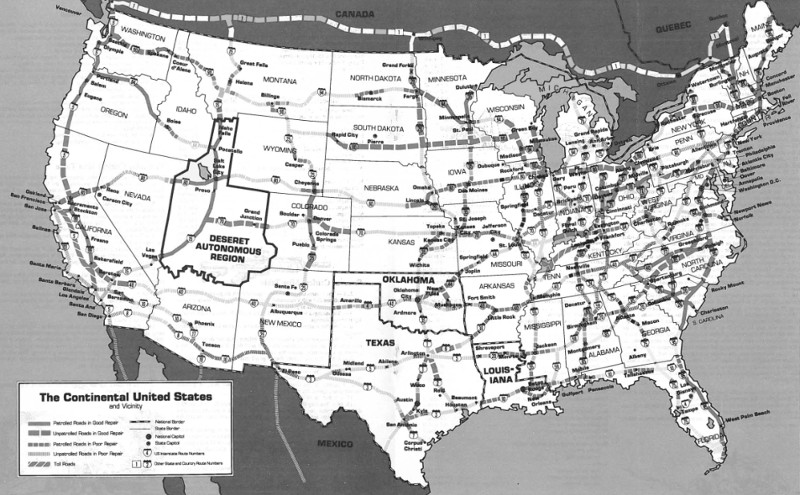
Scenario Ideas
Mission of Mercy is where a town is menaced by a toxic spill that contaminated their, and the PCs are hired by Amalgamated Medical to provide an antitoxin to help the poisoned townspeople. (Their helicopter broke, apparently) They suggest, of course, putting random obstacles in the PC's way - bikers or raiders, an ambush by a madman who originally spilled the toxin, locals driven mad by the toxins, etc.
The New Blight proposes an older relative of a PC - a PI - died under mysterious circumstances. However, the body is recovered, and the PC is given their personal effects, including a key to a private mailbox that was put into storage when it wasn't paid off, but still recoverable. There they can find the detective's diary, which details a Dr. Edwin Myler, who performed mysterious experiments, and the PI was hired to find out about his shady activities, and it seems Myler might have been plotting to poison the world's food supply...
But yes, it turns out the Blight has an actual cause (only ever detailed in this adventure seed, AFAIK), Dr. Edwin Myler. The PCs can find more evidence, and try and stop him (operating under a new name) from implementing an algae-based version of the Blight to cause a new food shortage.
Wait, why is he trying to destroy the world's food anyway? Well, no time to explain, we're at the end of the book.
Other Stuff
We gets some pull-out quick reference charts, hex paper done at the Car Wars scale for copying, a map of Autoduel America, some "cardboard heroes" paper standees and GURPS-sized car counters, and that's the book.
Following this book are nine supplements - Car Warriors, a book of PC/NPCs with standees to use, Zombietown U.S.A., a zombie adventure that inexplicably contains rules to be adapted to either modern-day or the Autoduel setting, and seven AADA Road Atlas books, covering all of the United States minus Alaska and Hawaii, but also with Australia in there too. It's probably one of the GURPS settings that got the most support, only really being eclipsed by Transhuman Space (another strangely libertarian future).
It's interesting, mainly because it's one of those tradgame phenomenons that died out without much of an attempt at a revival - there hasn't really been anything truly like it since. Even RPGs with a strong vehicular element are a real rarity. That's not to say there haven't been attempts, but none of the successors have gained much of the fame or notice. And though Steve Jackson Games has started publishing it again, it's largely consisted of reprints rather than any new material. Personally, I'm still trying to work out why the Car Wars Card Game, of all things, got a reprint...
I also find it curious for its politics for the time it came out, championing Heinlein's "An armed society is a polite society.", a world where organized rule collapsed and it's up to individuals to take up maintaining the social order when government fails. Where gun control is represented by the maniacal EDSEL and the bloodsport promoters known as the AADA may well be the heroic knights of the setting. In that, it's not honestly that different from D&D worlds that depend on their roving adventurers to keep evil at bay, but it's far more curious when applied to our world.
But that's that, hope you enjoyed the look back, and drive safely!
